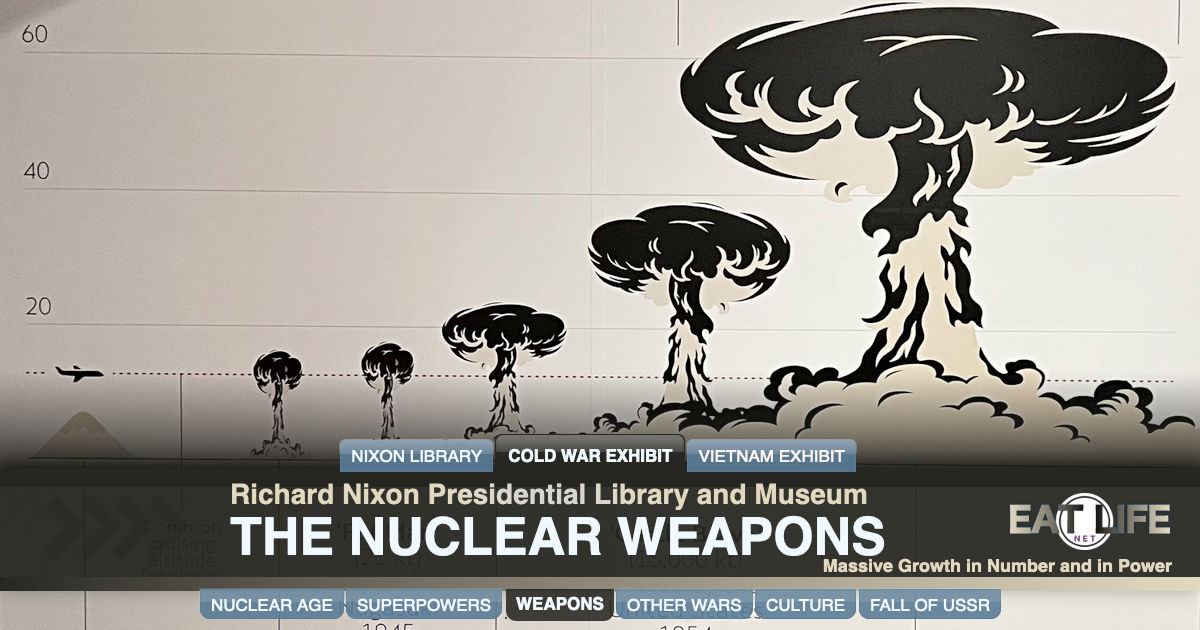- Castle Bravo
On March 1, 1954, the stakes were raised to new heights when the United States tested a hydrogen bomb, code named CASTLE BRAVO. Detonated over the Bikini Atoll in the South Pacific, this bomb was 1,000 times more powerful than the bomb dropped on Hiroshima just nine years earlier. CASTLE BRAVO was the most powerful nuclear device ever tested by the United States. - Tsar Bomba
In October 1961, the Soviet Union tested TSAR BOMBA, which had a yield of 50 million tons of TNT. TSAR BOMBA is the largest nuclear bomb ever detonated.
According to the Council on Foreign Relations, "During the Cold War, the United States and the Soviet Union together amassed some sixty thousand weapons. Each country possessed enough nuclear weapons to destroy the other several times over."
This enormous stockpile of weapons guaranteed that if one nation launched a nuclear attack, the other would respond in kind. This would lead to the complete destruction, not just of each other, but of the entire planet. Called Mutually Assured Destruction (MAD), this posture actually helped avoid nuclear war throughout the Cold War.
We are in the era of the thermonuclear bomb that can obliterate cities and can be delivered across continents. With such weapons, war has become not just tragic, but preposterous.- President Dwight D. Eisenhower, August 23, 1956

Operation Crossroads
- The BAKER Test (Operation Crossroads) was detonated on July 24, 1946 on the Bikini Atoll in the central Pacific's Marshall Islands.

Mushroom Cloud Heights
- Little Boy
(15 kt) dropped on Hiroshima 1945 - Fat Man
(21 kt) dropped on Nagasaki 1945 - Licorne
(1,000 kt) tested by France 1970 - Castle Bravo
(15,000 kt) tested by the United States 1954 - Tsar Bomba
(50,000 kt) tested by the U.S.S.R. 1961
Note: Mushroom cloud heights are approximate. The yield of a nuclear weapon is expressed in kilotons (kt). One kiloton equals 1,000 tons of TNT.

B57 Nuclear Bomb
- The MK-57, developed in 1963, remained in the nuclear stockpile until 1992. These small bombs were carried on U.S. Navy aircraft and used by the Navy, Marines, and Air Force.
If used in war, the B57 would have been dropped on enemy forces by high-speed tactical aircraft of the United States Navy and Air Force, including severall fighter planes, or used by certain United States Navy helicopters as an anti-submarine weapon.
Six different models of the B57 were developed, with explosive yields ranging from five kilotons to 20 kilotons. By comparison, the two atomic weapons dropped on Japanin 1945 to end World War II were 15 and 20 kilotons. One kiloton is the equivalent of 2 million pounds of TNT.
This decommissioned B57 nuclear bomb is 9 feet 10 inches long. When armed with a nuclear weapon, a B57 weighed about 500 pounds.
The United States produced 3,100 of these weapons. The last B57 was retired from America's nuclear arsenal in June 1993.
The S-3A, HS-10 Helicopter, and F-4 Phantom are three aircraft capable of dropping the B57 nuclear bomb.

S-3A
- Capable of dropping the B57 nuclear bomb

HS-10 Helicopter
- Capable of dropping the B57 nuclear bomb

F-4 Phantom
- Capable of dropping the B57 nuclear bomb











